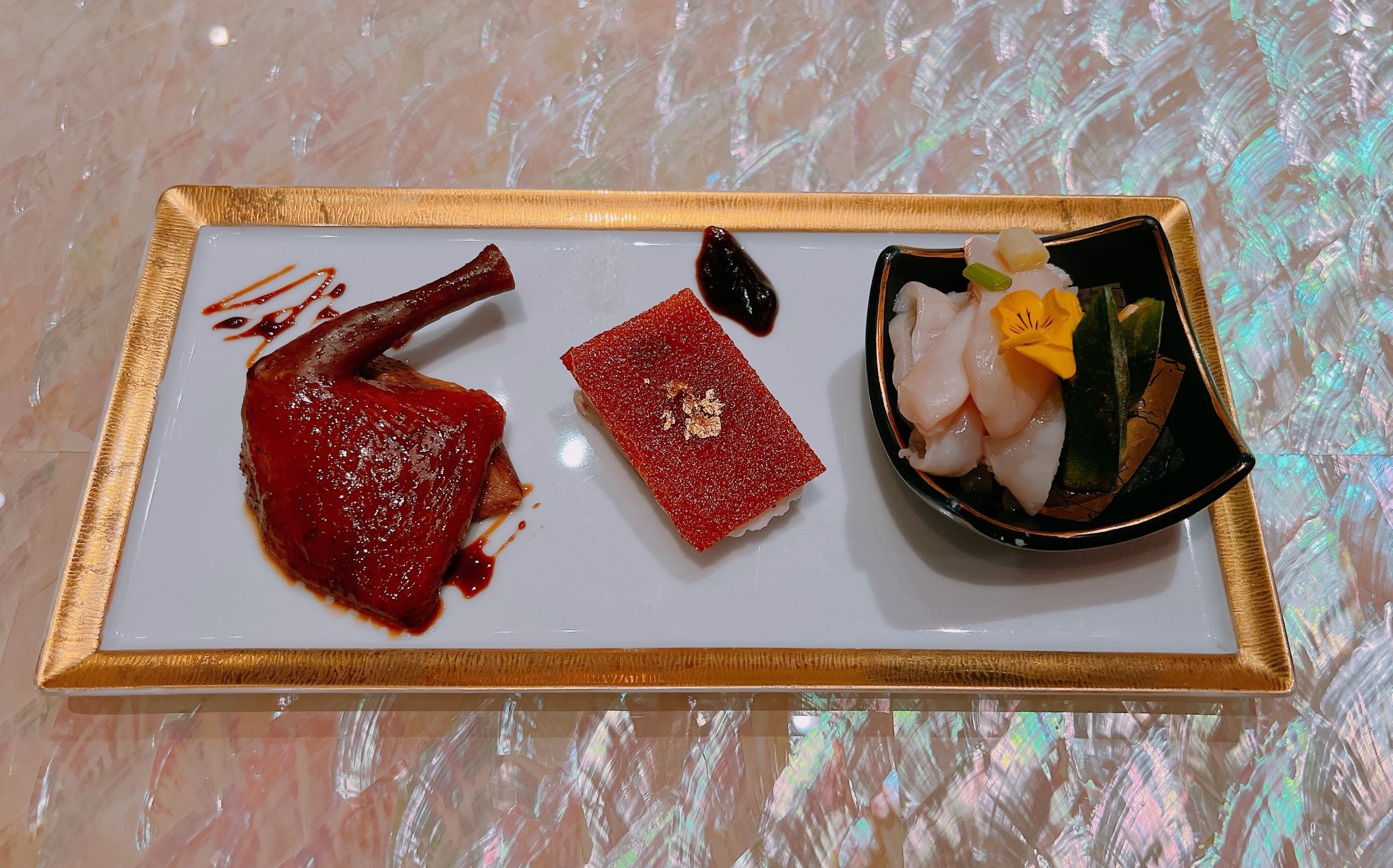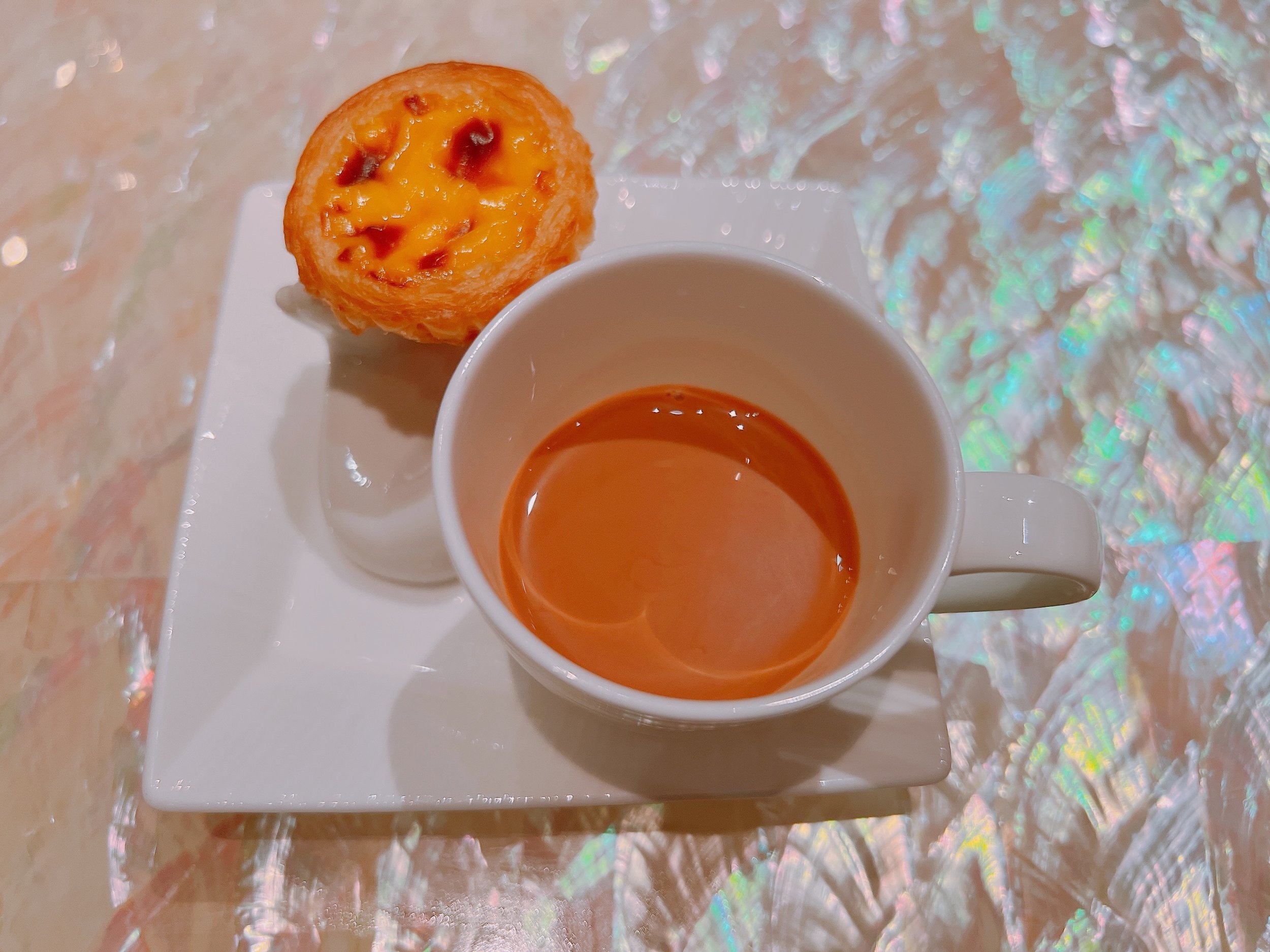The Eight - Macau
Rating: 16/20
Where: Macau, Macao
When: Dinner for 2 on 22 April 2023
Cost per Person: Tasting menu 3280 MOP, Wine pairing 800 MOP
Accolades: 3 Michelin Stars (2014-2023)
Why: Cantonese cuisine with elevated ingredients in a fancy setting; extensive wine list
The Grand Lisboa hotel in Macau is home to not just one but two three-Michelin-star restaurants, a world record of sorts. The two restaurants couldn't be more different, though. A few years ago, we had visited Joel Robuchon, a French restaurant on the top floor of the hotel, so this time we ate at “The Eight”, which serves Chinese cuisine on the second floor. One thing that the two restaurants do have in common is their wine cellar, which explains why the wine list is unusually long for a Chinese restaurant.
The Eight's interior is swanky, in particular if one is looking for a marriage of Chinese decor and the 1990s. There were lots of mirrors, glittery objects, and the colors red and black were dominant, making the interior feel a bit dark. As a modern rendition of a Chinese fine-dining experience, it felt more impressive than warm. The service was equally professional but detached. Part of the reason might have been that the staff's English was not quite as good as what we had experienced at other restaurants in Macau (or Hong Kong, for that matter). We were able to communicate fine, but food descriptions didn’t go beyond what was already printed on the menu. Knowledge of Mandarin or Cantonese is definitely a plus here.
We chose the restaurant's tasting menu, but there was also a very extensive a la carte menu running to over fifty pages. One could eat here for several weeks on end without having to repeat a single dish. Regarding beverages, there was a four glass wine pairing on offer. Sadly, these wines were only of average quality, and one of them went quite poorly with the food. Not something that I'd get again, especially since (a) the tasting menu comes with a decent complimentary tea and (b) there were thirteen wines by the glass, which for all I know might actually be better choices to complement the tasting menu.
Two bites served on soup spoons started our dinner. First, we had a turnip and two mushrooms that were dressed with a mushroom sauce. Unfortunately, there was very little of that sauce, but what was there was very nice and went well with the turnip 17.
Second, we tried a small abalone that had been placed on top of some celtuce strips. The fresh abalone had lots of bite, and tasted a bit earthy. Another quite nice amuse bouche - assuming that one likes abalones that are a bit chewy 16.
A triple of amuse bouches was our first stop on the printed tasting menu. Razor clams with okra and Sichuan peppers were served cold, and were very good indeed. The dish contained two different cuts of clam - one softer and one chewier. The slightly numbing spice was a nice addition, although it's a bit ironic that the first dish on a tasting menu would be something that impairs one's tastebuds 18.
Roasted suckling pig was presented in three layers: pork meat on the bottom, then a thin layer of bao dough and finally crispy pork skin on top. A sweet dipping sauce and some sugar (!) were available to season this bite. I thought the deconstructed bao was a neat idea, and the pork skin was nicely crunchy. But overall, this lukewarm dish didn't wow me tastewise: it was fine, but not particularly distinctive. More flavor in the (very) well-done meat would have helped 15.
Better was the tea smoked pigeon that was served with a homemade soy sauce. The meat was merely ok, unfortunately also cooked quite well-done. But what made this dish was the sauce, it had a nice bbq/sweet caramel flavor to it - very lovely 16.
For the second course, we had to pick among two choices. Between the two of us, we thankfully got to try both of them. Option number one was a broth containing shark fin, accompanied by sides of bean sprouts and vinegar. This was not the kind of shark fin soup where the fin's gelatin thickens the whole soup, in fact, this broth was quite light. Unfortunately, the soup was otherwise pretty unremarkable, and the shark fin had the consistency of thin noodles. Not a wowing dish 15.
The second option for this course was a soup that contained snow crab meat, matsutake mushrooms and a bird's nest that had been placed inside a bamboo pith mushroom. Sadly, the broth here was even worse than for the shark fin soup. Very salty and not particularly flavorful, it reminded me (unfavorably) of a dried soup mix. The matsutake had the consistency of canned mushrooms, and was somewhat chewy; the bamboo pith was surprisingly spongy, like (edible) foam wrap. More texture than taste here, which also went for the initially hidden bird's nest. The best part of the dish was the crab meat, but overall this fell far short of expectations 14.
A classic Cantonese fine-dining dish came next: abalone in a brown sauce with a side of asparagus. In this case, the Japanese abalone was fresh, so it had a nice bite, but it was hard to cut with the provided utensils. With a size of 28 per pound it was a relatively large specimen, which goes a long way toward explaining the price of the tasting menu. Very nice. The sauce was fine, but not as good as we had on the previous two nights in similar dishes. The asparagus was lightly blanched and still maintained its crunch. An objective rating here might say 16 or 15, but I really liked the abalone 17. The weirdest thing about this dish was the paired wine, a very sweet Sauternes. The pairing was not a total disaster, but it wasn't a very good match either. When I asked our server about the thinking behind this pairing, she just replied “I don't know. I suppose it matches the food.” With a wine cellar as deep as this restaurant’s, I’m sure they could have found a more appropriate wine.
A skin-on filet of grouper was our next course. The main seasoning here were some black bean sauce and garlic that were hidden underneath the fish. Unfortunately, the decently cooked, fatty fish didn't have much inherent taste, so the black bean sauce would have been a key ingredient, but there was very little of it - more seasoning would have been better. The radish and dried ginger on the side didn't help much in that regard. At least the Chinese broccoli looked pretty and was nicely crunchy. A dish with potential - if there had only been more seasoning, this would have been much better 16.
The next course sounded near perfect on paper: wok-fried A5 Kagoshima beef with spring onions. How could this possibly not be an amazing dish? Well, one way is to start by severely overcooking the beef so that all its marbling is gone, and one is left only with chewy cubes. Then it helps to barely season the beef, to make sure it doesn't taste of much. And finally, by serving the spring onions essentially raw, to provide a jarring sharpness. For a neighborhood Chinese restaurant, this result might be considered satisfactory, but given the kitchen's ambitions and the quality of the ingredients (Japanese A5 beef), it was highly disappointing. This could have been - should have been - so much better... 14
Luckily, we ended the savory courses on a positive note. Vermicelli noodles, lobster and mushrooms were served in a shrimp-based broth seasoned with Sichuan peppers. This soup was amazingly good, it's hard to believe that it was made by the same kitchen that produced the earlier lackluster soup courses. This broth was complex: sweet, sour, and spicy with a nice numbing punch from the Sichuan pepper. It all came together as a delicious whole. Easily a 19 by itself. I liked the noodles (since they were nicely soaked in the soup) and the crunchy mushrooms. The lobster was fine as well, but didn't wow me as much as the soup 18.
The main dessert was a study in black and white - sesame that is. Two puddings made from white and black sesame were arranged in a yin-yang pattern. And the two puddings did actually taste different: the black pudding was nuttier whereas the white pudding was creamier. A pleasant enough dish. Much better was the accompanying sesame ice cream that was studded with crunchy black sesame seeds. Quite delicious, and very sweet, it arguably didn't have much sesame taste except for the seeds stuck to it, but that's nitpicking. On average for the two 16.
Our final bite was a little egg tart (the Macau version of a Portuguese nata), served with a cup of hot Hong Kong style milk tea. The egg tart was much better than the one I had earlier in the day in old-town Taipa. Very sweet, crispy and creamy - excellent. I liked the tea as well, but it was not necessarily better than what would could find at a local milk tea shop 17.
Overall: The Eight served mainly Cantonese food, incorporating a few influences from other Chinese cuisines (for example, the liberal use of Sichuan pepper). The tasting menu was quite expensive, which can be explained by the high quality of the ingredients used (Japanese beef, large Japanese abalone, etc). However, for the most part, the kitchen didn't do those ingredients justice, leading to tragically underwhelming dishes. The service was a bit perfunctory as well, for example the menu descriptions in English were word-by-word what was printed on the menu. Based on our experience, this was nowhere close to three Michelin stars, but then again, we tried less than 5% of the dishes available on the a la carte menu, so there might be some hidden gems 16.











